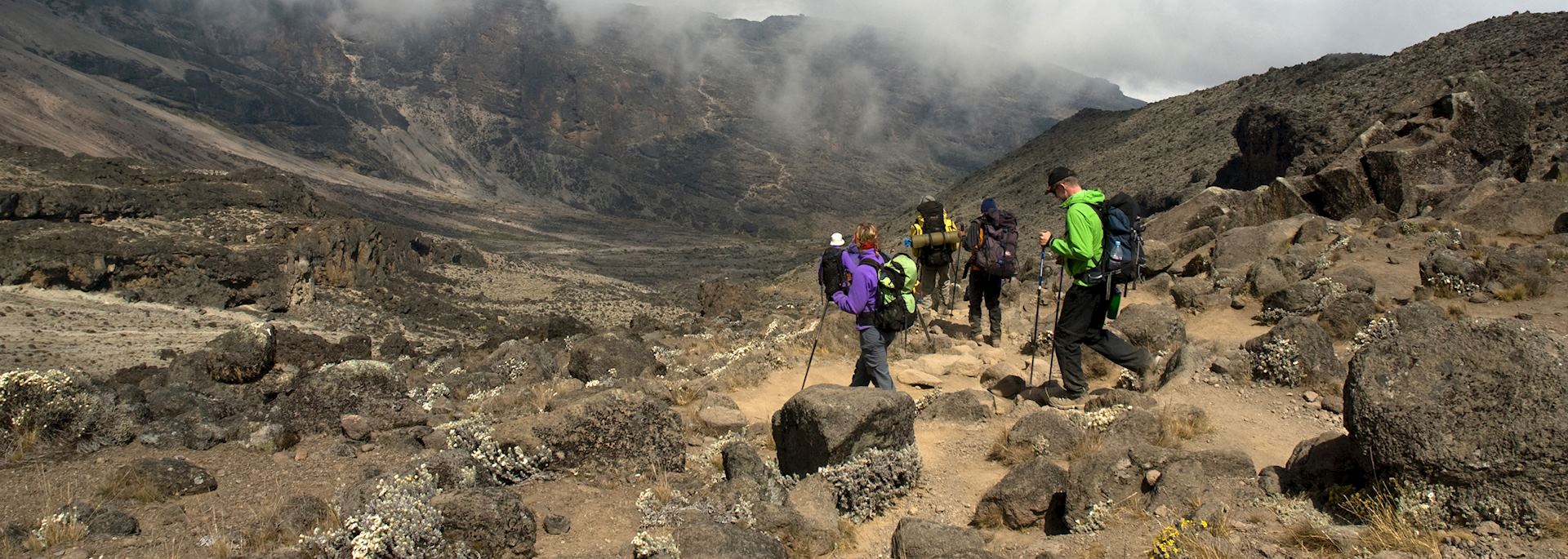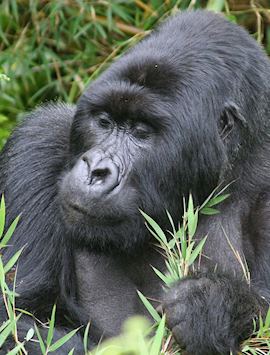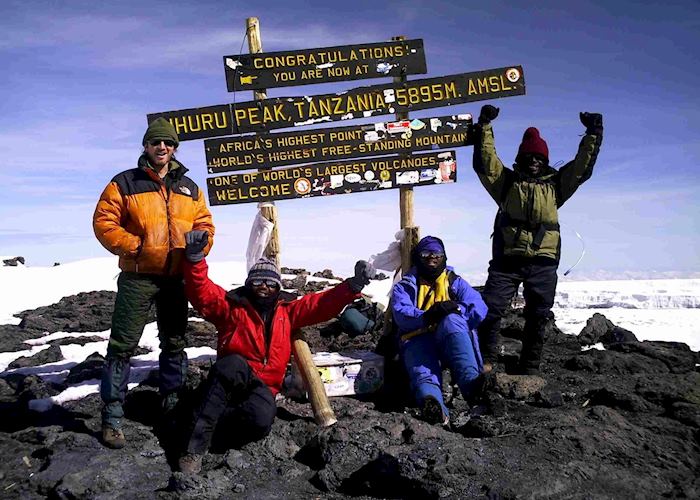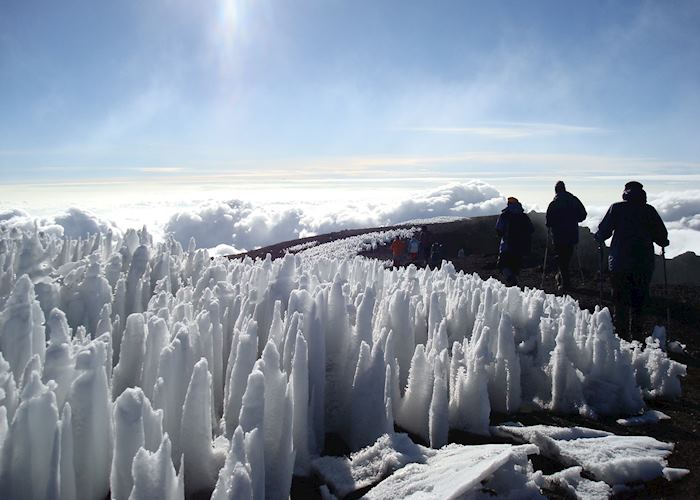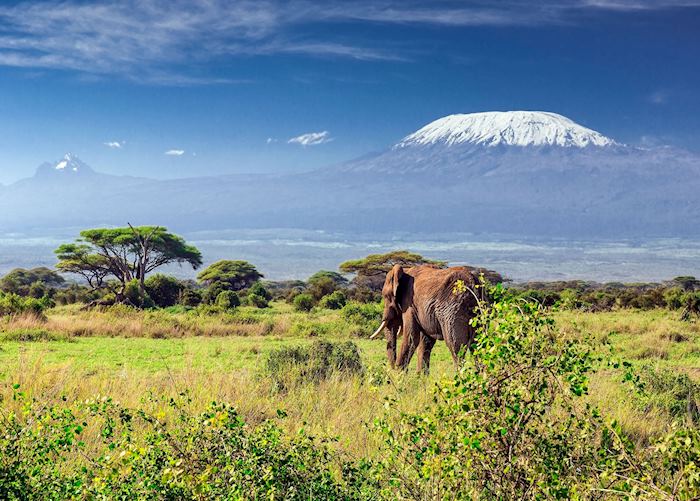Jump to:
A dormant volcano in northern Tanzania, Mount Kilimanjaro stands at 5,895 m (19,341 ft) and is the continent’s tallest mountain. Often considered one of the most accessible big-mountain climbs, some 35,000 people attempt to reach its summit, Uhuru Peak, every year.
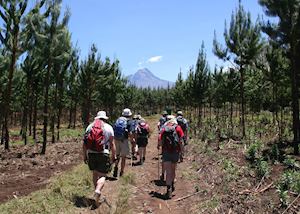 While the climb’s far from easy, you’re rewarded with seemingly endless views over the jagged peaks of Mawenzi, the Shira plateau, and the distant horizons of Tanzania and Kenya far below. And, we can arrange for you to hike with the best, most experienced guides to give you the greatest chance of reaching the top safely.
While the climb’s far from easy, you’re rewarded with seemingly endless views over the jagged peaks of Mawenzi, the Shira plateau, and the distant horizons of Tanzania and Kenya far below. And, we can arrange for you to hike with the best, most experienced guides to give you the greatest chance of reaching the top safely.
Kilimanjaro is a natural wonder: a snow-covered mountain on the Equator, it’s home to five climate zones, each with their own distinct vegetation. Climbing the mountain feels like walking through four seasons in a week. The high altitude has created habitats for unusual life forms, such as the alien-looking giant groundsel plant and the delicate elephant flower.
You might have seen media coverage of numerous celebrities who have reached Kilimanjaro’s summit or know someone personally who has. Being non-technical and the easiest climb of the Seven Summits, the mountain attracts novice and experienced mountain trekkers alike.
But, it’s important to acknowledge that getting to the top shouldn’t be taken for granted. Kilimanjaro is ascended quickly for its height, which can cause altitude sickness and fatigue. Having the best possible guides and porters is an important factor in your chance of success at reaching the summit.
Our Kilimanjaro guides
 We can arrange for an extensive team of mountain guides, cooks and porters to accompany you on your climb. There are many groups operating on the mountain, some more professional than others. Our priority lies not only in guaranteeing that you trek with the best and most experienced crew, but also that the guides and staff we use are treated responsibly, with proper gear and fair wages. Their welfare, continued training and educational opportunities are at the forefront of our consideration, and each year they undergo an assessment to ensure they’re at the top of their game.
We can arrange for an extensive team of mountain guides, cooks and porters to accompany you on your climb. There are many groups operating on the mountain, some more professional than others. Our priority lies not only in guaranteeing that you trek with the best and most experienced crew, but also that the guides and staff we use are treated responsibly, with proper gear and fair wages. Their welfare, continued training and educational opportunities are at the forefront of our consideration, and each year they undergo an assessment to ensure they’re at the top of their game.
Your guides will be trained in mountain first-aid, and the team will have a medical porter carrying a collapsible stretcher, hyperbaric chamber and medical-use oxygen. Your oxygen and hydration levels will be regularly checked, and you’ll be given advice on ways to reduce your risk of altitude sickness and alleviate any symptoms.
The guides we work with are also mindful of the environment and have a ‘leave no trace’ policy. They adhere to the rules of the national park and bags come down as heavy as they were on the way up.
Choosing your route up Mount Kilimanjaro
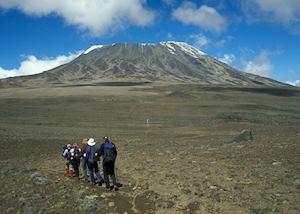 There are several routes that you can take up the mountain. The most popular is the Machame or ‘Whiskey’ route, which takes you to the peak from the southwest, passing through rainforest, heather-moorland and alpine desert. At some points you’ll have views over to conical Mount Meru, Tanzania’s second highest mountain.
There are several routes that you can take up the mountain. The most popular is the Machame or ‘Whiskey’ route, which takes you to the peak from the southwest, passing through rainforest, heather-moorland and alpine desert. At some points you’ll have views over to conical Mount Meru, Tanzania’s second highest mountain.
While it’s possible to complete this route in six days and five nights, we recommend adding an extra day and night. This gives you more time to recover for the final leg of the climb. You can do this route as part of a group or on a private basis. It’s great for people who have less time to climb the mountain, and its wild and varied scenery make it a rewarding climb.
The Lemosho route approaches Kilimanjaro from the west. Because you begin the climb at a higher altitude and spend a longer period on the mountain (usually around eight days), you’re better able to adjust to the thinner air, making a successful summit more likely.
The route takes you through forest, where you might see black and white colobus monkeys and brightly plumed turacos among the branches. It also crosses the Shira Plateau, a large caldera believed to have been the first of Kilimanjaro’s three volcanic cones to collapse some half a million years ago. You’ll usually trek this route privately.
Camping on Mount Kilimanjaro
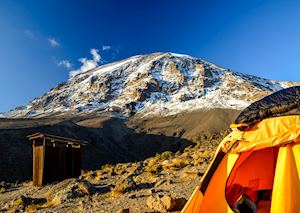 Each day, your porters rush off ahead to get the best spot at the next camping site. They carry the equipment with them, up to 20 kg (44 lbs) each. The tents are bright orange and grey, so are easy to spot as you approach the end of that day’s trek.
Each day, your porters rush off ahead to get the best spot at the next camping site. They carry the equipment with them, up to 20 kg (44 lbs) each. The tents are bright orange and grey, so are easy to spot as you approach the end of that day’s trek.
You won’t spend a great deal of time in camp, using it as a base to eat, sleep and rest. You’ll sleep in basic, dome-shaped tents, and there’s a shared chemical toilet for guests. Water is limited so there are no showers, but you’ll be provided with hot water in the morning for a quick freshen up.
Hearty, nutritious meals are served in the mess tent, often consisting of chicken, beef or plantain stews and plenty of carbohydrates. Altitude sickness might result in a loss of appetite, but it’s important to eat as much as possible to keep your energy levels up. You’ll also need to drink more water than usual, so soups are also served to keep up your liquid intake.
Best time to climb Mount Kilimanjaro
It’s possible to climb Kilimanjaro at any time of year, but we recommend avoiding the wetter months. For the best chance of dry conditions, hike between July and October or January to mid-March.
who's been there

Start planning your tailor-made trip to Mount Kilimanjaro by contacting one of our Tanzania specialists
-
01993 838 92501993 838 545
- Make an enquiry
Suggested itineraries featuring Mount Kilimanjaro
Our itineraries will give you suggestions for what is possible when you travel in Mount Kilimanjaro, and they showcase routes we know work particularly well. Treat them as inspiration, because your trip will be created uniquely by one of our specialists.
Places near Mount Kilimanjaro
- West Kilimanjaro 19 miles away
- Arusha 51 miles away
- Ol Doinyo Lengai 102 miles away
- Lake Natron 104 miles away
- Lake Manyara National Park 110 miles away
- Tarangire National Park 115 miles away
- Karatu 118 miles away
- Ngorongoro Crater 131 miles away
- Northern Tanzania 131 miles away
- Lake Eyasi 162 miles away
- Serengeti National Park 190 miles away
- Tanzania's Swahili Coast 202 miles away
- Saadani 223 miles away
- Bagamoyo 257 miles away
- Mikumi National Park 289 miles away
- Dar es Salaam 292 miles away
